![]()
![]()
![]()
Use LEFT and RIGHT arrow keys to navigate between flashcards;
Use UP and DOWN arrow keys to flip the card;
H to show hint;
A reads text to speech;
117 Cards in this Set
- Front
- Back
|
1. Food Science |
An integrated course involving many disciplines. |
|
|
2. Pure Food and Drug Act and the Food, Drug, and Cosmetic Act |
Formed |
|
|
3. Adulterated food |
Lowered quality and safety of a product caused by adding ingredients that may be toxic. |
|
|
4. Food analog |
Natural or manufactured substances uses in place of foods or food components. |
|
|
5. Criteria necessary for an experiment to be scientific .... |
It must be replicable or repeatable. |
|
|
6. Metric prefixes: Milli, Deci, Centi,Kilo |
Largest to smallest |
|
|
7. Tare |
Mass of an empty container-- this is erased when you Tate an electronic balance. |
|
|
8. Mass |
A measure of the quantity of matter |
|
|
9. Psychological influences on food choices ... |
Taste biases; mental associations between food and emotion; brand preferences. |
|
|
10. Number of samples and sensory testing |
4-5 samples can be reliably evaluated, any more and results may become flawed. |
|
|
11. Solvent |
Substance that does the dissolving in a mixture. Water is the universal solvent. |
|
|
12. Subatomic particles |
Protons, electrons, neurons |
|
|
13. Physical/Chemical changes |
Physical change does not change the molecular structure. Chemical changes from new substances as indicated by color or odor changes. |
|
|
14. Heterogeneous mixture/ Homogeneous mixture |
Heterogeneous mixtures contain non uniform distribution of particles. Homogeneous mixtures contain a uniform distribution of particles. |
|
|
15. Solute |
Material that is dissolved in a solution. |
|
|
16. Astringency and examples of astringent foods... |
Ability of foods to draw up the muscles in the mouth. |
|
|
17. Calories per gram of fat, carbohydrates, and protein |
9,4,4 |
|
|
18. Convection energy |
Heat transfer as a result of the motion of fluid or gases. |
|
|
19. Enzymes |
Specialized proteins that speed up or starts a chemical reaction without being changed by it. Identified by the suffix "ase". |
|
|
20. Monosaccharide examples |
Simplest CHO structure, include glucose, fructose, and galactose. |
|
|
21. Buffers |
Help stabilize the pH by absorbing excess acids and bases. |
|
|
22. Techniques for keeping sugar crystals in candy small... |
Use interfering agents, cool slowly, use corn syrup, beat vigorously after cooling, let candy ripen. |
|
|
23. Interfering agents |
Substance that slows or prevents crystal growth. Ex: butter, cream, and egg whites. |
|
|
24. Elements found in carbohydrates |
Carbon, Hydrogen, and Oxygen |
|
|
25. Three types of lipids found in the human body |
Triglycerides, phospholipids, and sterols. |
|
|
26. Characteristics of saturated and unsaturated fats: |
Saturated- contain the maximum amount of hydrogen atoms, no double bonds. Unsaturated - do not have the maximum amount of hydrogen atoms. |
|
|
27. Peptide bond |
A bond formed between two amino acids. |
|
|
28. Functions of protein |
Assist with growth and repair, maintain pH balance, some act as enzymes, maintain fluid and mineral balance, supply energy. |
|
|
29. Maillard reaction |
Reaction between carbohydrates and protein that cause food to brown. |
|
|
30. Hydrogenation |
Process whereby an unsaturated fatty acid is converted to a saturated fatty acid. |
|
|
31. Complete proteins |
Contain all the indispensable (essential) amino acids. Must be supplied by the diet. |
|
|
32. Denaturation |
Changing the shape of a protein molecule without breaking peptide bonds. |
|
|
33. Functions of antioxidants, 3 major antioxidants |
Help reduce the damaging effect of free radicals in the body. |
|
|
34. Labeling of synthetic dyes |
Must include use, shade, and number, i.e. F,D &C red #40. |
|
|
35. Two-step fermentation |
Fermentation consisting of lactic acid fermentation and other microbes in a second step.Aged cheese, say sauce, and sourdough. Acetic acid fermentation follows yeast fermentation when making vinegar. |
|
|
36. Bacterial fermentation |
Utilizing microbes in the fermentation process. Sauerkraut, pickles, olives, dry sausage, and cultured dairy products. |
|
|
37. Acetic acid fermentation |
What vinegar results from. |
|
|
38. Clostridium botulism |
Causes food intoxication, found primarily in home canned goods and honey (infants). |
|
|
39. Food infection |
Caused by microbial digestive enzymes that damage the body tissues; include the bacteria listeria monocytogenes, and salmonella, parasites and viruses |
|
|
40. Food intoxication |
Causes by a toxin released by microbes; include Clostridium perfringens, staphylococcus aureus, and C.bot. |
|
|
41. Prion |
Misfolded protein that can cause infection. |
|
|
42. 4 C's of food safety |
Cook, clean, chill, combat cross contamination. |
|
|
43. Danger zone |
Range of temperature where bacteria multiply, 40-140℉. |
|
|
44. Cross- contamination |
Transfer of bacteria from one source to another. |
|
|
45. Aseptic canning |
Sometimes called UHT (ultra high temperature) sterilization. |
|
|
46. Blanching |
Briefly submerge food in boiling water or suspending food over stem to denature enzymes. Often done before freezing vegetables. |
|
|
47. Commercial sterilization |
Level of heat preservation used for canned foods and sealed containers. |
|
|
48. Hydro static cooker and cooler |
Modified U-shaped tube filled with water and steam that processes filled containers. |
|
|
49. Pasteurization |
Processing food under low temperatures over a period of time to kill microbes. |
|
|
50. Retort |
Large commercial pressure canner. There are still and agitating retorts. Head space must be considered (the slave between the food inside the jar and the lid). |
|
|
51. Sterilization |
Complete destruction of microbes. |
|
|
52. Headspace |
The amount of space between a food product and the inside surface of a lid. |
|
|
53. Single celled organisms that have a positive effect on food |
Bacteria, and fungi (yeast and molds). |
|
|
54. Dehydration methods |
Include spray, tray, belt, and drum drying. Spray drying is the fastest drying method. |
|
|
55. Unwanted rehydration |
Occurs most often in mixtures of foods containing varying moisture levels. |
|
|
56. Case hardening |
Occurs when food had been improperly dehydrated, a hard, dry skin forms on the outside of a food while moisture gets trapped inside. |
|
|
57. pH |
Scale ranges from 1-14, 7 is neutral. Acids have a range of 1-6.9, bases range from 7.1-14. |
|
|
58. Sol, paste, gel- viscosity of each |
Sol- pourable thickened liquid, paste -thickened mixture of starch and liquid that is heated; very little flow. Gel- ridged starch mixture. Sol is the least viscous, while gel is the most viscous. |
|
|
59. Gelatinization point |
The temperature at which maximum swelling occurs. |
|
|
60. Opacity vs. Translucency in starches |
Cornstarch produces a translucent gel, flour produces an opaque mixture. |
|
|
61. Modifies starch |
Are changed structurally by chemical or mechanical means; often made from corn, wheat, or soy. |
|
|
62. Rancidity |
Occurs with fats and is a result of enzyme activity. Fats take on an off flavor and odor. |
|
|
63. Oxidation |
When substances are damaged by the effects of oxygen. In fats, oxidation causes rancidity. |
|
|
64. Iron absorption |
Increased when vitamin C rich foods are consumed with iron containing foods. Decreased when coffee and tea are consumed with iron containing foods. |
|
|
65. Riboflavin |
Light sensitive B vitamin. |
|
|
66. Enrichment |
Restoring nutrients lost during processing. |
|
|
67. Covalent bonds |
Bond in which electrons are shared equally. |
|
|
68. Ionic bonds |
Bond in which electrons are transferred. |
|
|
69. Water activity |
A measure of perishability of food. The higher the water activity, the more perishable the food is. |
|
|
70. Free water |
Water that is easily separated from food tissue. |
|
|
71. Bound water |
Water tried to the structure of large molecules. |
|
|
72. Coagulation |
Permanent denaturation |
|
|
73. Denaturation |
#32 |
|
|
74. Emulsion |
Mixture of two immiscible liquids where one is dispersed in droplet form in the other |
|
|
75. Foam |
Foams are formed by bubbling gas through mixture, beating or whipping and depessurization. |
|
|
76. Gelatinization |
Function of protein and carbohydrates. Protein gels are found in puddings. |
|
|
77. Texturization |
Globular proteins that are spun into fibers under the right conditions known as texturizing |
|
|
78. Allylsulfides |
A group of compounds that contain sulfur and increase enzyme reactions. |
|
|
79. Idoles |
Found in large amounts in broccoli and the crux I Fe Roy's vegetables. |
|
|
80. Isoflavones |
A subgroup of flavonoids found mainly in soy products and legumes. |
|
|
81. Polyphenols |
This phytochemical family may reduce risk of some cancers and heart disease. |
|
|
82. Saponins |
Appears to block DNA reproduction in cancer. |
|
|
83. Terpenes |
Responsible for the flavors of citrus fruits and many herbs and seasonings. |
|
|
84. Anti caking agents |
Absorb moisture to keep powdered and crystalline ingredients from caking or lumping. |
|
|
85. Antimicrobial agents |
Preservatives that prevent growth of microbes in food. |
|
|
86. Humectants |
Help products retain moisture control crystalline growth and regulate water activity |
|
|
87. Maturing and bleaching agents |
Are chemicals that speed the aging process and whiten flour. |
|
|
88. pH control agents |
Additives that alter or stabilize the pH of a food mixture. |
|
|
89. Preservatives |
Substances added to food to prevent or slow spoilage and maintain natural colors and flavors. |
|
|
90. Myoglobin |
Responsible for the red juice that pools around meat cuts. |
|
|
91. Casein/whey |
Casein is the protein that forms curds in cheese. Whey is the watery byproducts of cheese products. |
|
|
92. Chemical leavening agents |
Help food rise |
|
|
93. Syneresis |
The leaking of a liquid from a gel |
|
|
1. |
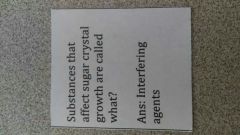
|
|
|
2. |
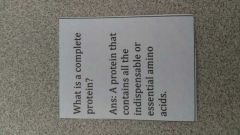
|
|
|
3. |
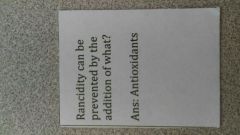
|
|
|
4. |
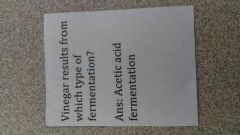
|
|
|
5. |
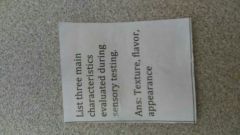
|
|
|
6. |

|
|
|
7. |

|
|
|
8. |
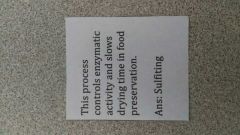
|
|
|
9. |
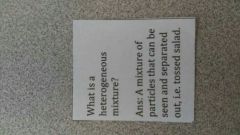
|
|
|
10. |

|
|
|
11. |
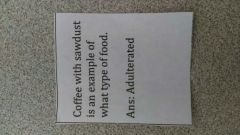
|
|
|
12. |
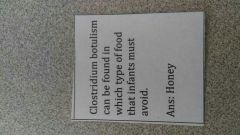
|
|
|
13. |
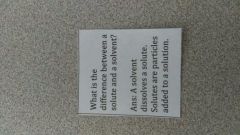
|
|
|
14. |
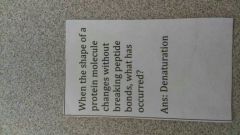
|
|
|
15. |

|
|
|
16. |

|
|
|
17. |
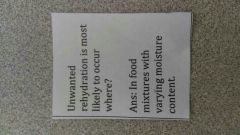
|
|
|
18. |

|
|
|
19. |
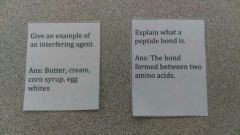
|
|
|
20. |
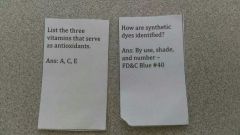
|
|
|
21. |
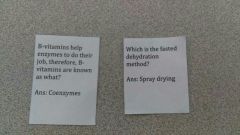
|
|
|
22. |
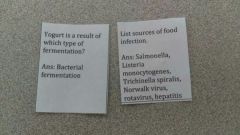
|
|
|
23. |
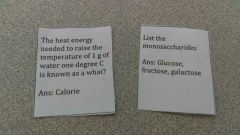
|
|
|
24. |

|

